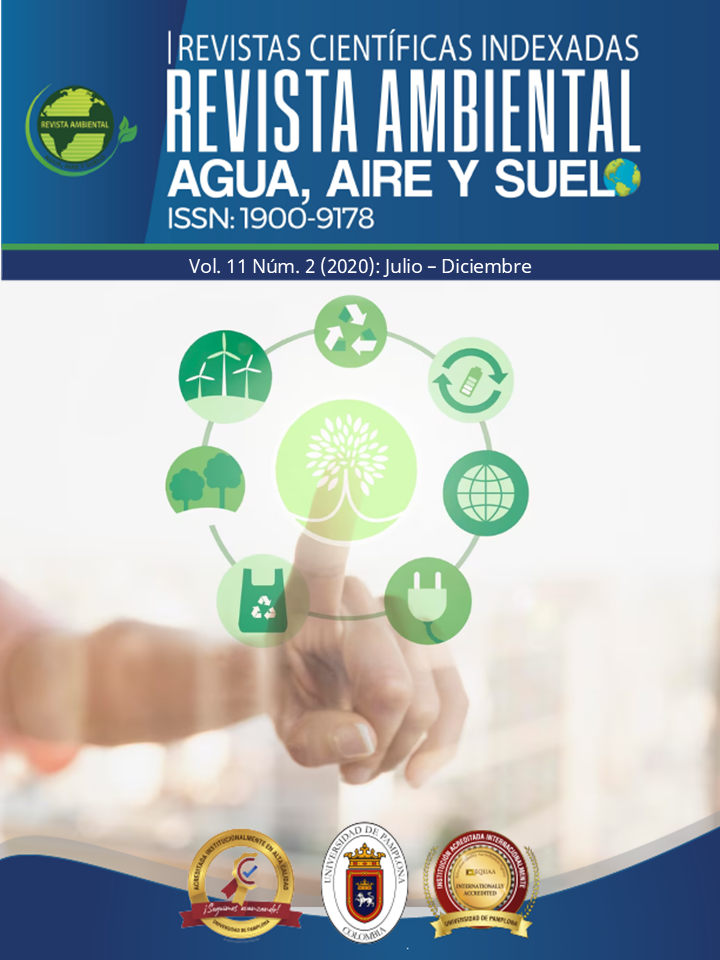Alternativas de reúso y ahorro de agua potable por discontinuidad en el abastecimiento
DOI:
https://doi.org/10.24054/raaas.v11i2.2480Palabras clave:
Aprovechamiento de agua, Dotación de agua, Reúso de aguaResumen
Colombia es el tercer país con mayor cantidad de agua en el mundo, pese a esto, 13.8 millones de habitantes no tienen acceso al agua potable. Actualmente en Villa del Rosario (Norte de Santander, Colombia), se presenta un elevado desarrollo urbanístico debido a la necesidad de vivienda en la región, pero la infraestructura del acueducto existente presenta falencias importantes que no permiten garantizar la continuidad en la prestación del servicio. El servicio es prestado en promedio dos veces por semana, y las acciones de mejora para solucionar esta problemática están planteadas a mediano y largo plazo debido a la inversión económica para dar soluciones de fondo. Por esto, se hace necesario evaluar alternativas de reúso y ahorro del agua como una medida de solución a corto plazo para disminuir el consumo y poder garantizar que el volumen almacenado pueda durar más días. Se analizó el consumo básico de una vivienda midiendo el volumen gastado en las actividades diarias, donde se pudo determinar que los aparatos críticos en los que se pueden implementar alternativas de ahorro y reúso de agua mediante su aprovechamiento como aguas grises son la lavadora, el sanitario y la ducha; dando como resultado una reducción del consumo promedio mensual de una vivienda entre 10-13 m3 para un tanque de almacenamiento de 2000 L. Esto probablemente permite ampliar en seis días el tiempo sin tomar agua potable desde la red pública.
Descargas
Referencias
Alcaldía Municipal de Villa del Rosario (2000). Acuerdo_043_2000 - Alcaldía Municipal de Villa Del Rosario en Norte de Santander. [Online]. Disponible en: http://www.villadelrosarionortedesantander.gov.co/normatividad/acuerdo_043_2000.
Arnold, B. C. (2015). Pareto Distribution. In Wiley Stats Ref: Statistics Reference Online (pp. 1–10). John Wiley & Sons, Ltd. https://doi.org/10.1002/9781118445112.stat01100.pub2
AQUALIA SA ESP, Empresa de Servicios Públicos de Villa del Rosario, Norte de Santander, Colombia. (2017). Reporte de Consumos de Vivienda.
Bermejo Arnaldos, D. (2012). Reutilización de aguas residuales domésticas. Estudio y comparativa de tipologías edificatorias: depuradoras naturales como alternativa sostenible. Disponible en: http://hdl.handle.net/10045/29576
Céspedes, R. (2013). Factibilidad de reúso de aguas negras en edificaciones. Escuela de ingenieros. Disponible en: https://repositorio.escuelaing.edu.co/handle/001/112.
Colglazier, W (2015) Sustainable development agenda: 2030. Science, vol. 349, No. 6252, pp. 1048–1050, https://doi.org/10.1126/science.aad2333
Departamento Administrativo Nacional de Estadística (DANE). (2008). Proyecciones Municipales 2006-2020, Metodología. https://www.dane.gov.co/files/investigaciones/poblacion/proyepobla06_20/MProyeccionesMunicipalesedadsexo.pdf
Departamento Administrativo Nacional de Estadística, (DANE). (2010). Perfil Municipal Villa del Rosario, Censo General 2005 (p. 6). DANE.
Departamento Nacional de Planeación, D. N. P. (2014). Evolución de las coberturas de los servicios de acueducto y alcantarillado (1985-2013).
Domínguez Calle, E. A., Rivera, H. G., Vanegas-Sarmiento, R. & Moreno, P. (2008). Relaciones demanda-oferta de agua y el índice de escasez de agua como herramientas de evaluación del recurso hídrico colombiano, Rev Acad Colomb Cienc., vol. 32, n.o 123, pp. 195–212.
Kestler-Rojas, J. P. (2004). Uso, Reúso y Reciclaje del Agua Residual en una vivienda. Universidad Rafael Landívar, Guatemala.
Jaramillo, M. (2010). Potencial de reúso de agua residual doméstica como estrategia para el control de la contaminación por agua residual en el valle geográfico del río cauca. Universidad del Valle. http://www.scielo.org.co/pdf/inco/v22n2/2027-8284-inco-22-02-9412.pdf
Kral, R. (2011). Sistema de tratamiento Casero de aguas jabonosas. Disponible en: https://agua.org.mx/biblioteca/sistema-casero-de-tratamiento-de-aguas-jabonosas/
Ministerio de Vivienda, C. y T. C. (2017). Resolución 0330 de 2017. http://www.minvivienda.gov.co/ResolucionesAgua/0330-2017.pdf
Nagua Caiminagua G. C. & Glenda (2016) «Recuperación de aguas residuales grises mediante biofiltros», Universidad Técnica de Cotopaxi, Latacunga - Ecuador, 2016 http://repositorio.utc.edu.ec/handle/27000/3564.
Niño Rodríguez, E. D., & Martínez Medina, N. C. (2013). Estudio de las aguas grises domésticas en tres niveles socioeconómicos de la ciudad de Bogotá. Pontificia Universidad Javeriana. http://repository.javeriana.edu.co/handle/10554/11139
Parra A, D. L., & Granados R, D. P. (2012). Estudio de alternativas para el aprovechamiento y reúso del agua doméstica. Universidad de La Salle. https://ciencia.lasalle.edu.co/ing_ambiental_sanitaria/896/
Plan Departamental de Aguas, P. D. A. Gobernación de Norte de Santander, (2014). Estudios y Diseños para Nuevas Redes y/o Optimización de Redes de Distribución Existentes en el Municipio de Villa del Rosario, Departamento de Norte de Santander.
Sistema Único de Información (SUI). (2018). Sistema Único de Información Superservicios Públicos Domiciliarios. http://www.sui.gov.co/web/acueducto/reportes/comerciales/indicadores-comerciales.
Superintendencias de Servicios Públicos, S.S.P. (2019). Disponible en: https://www.superservicios.gov.co/sala-de-prensa/comunicados/villa-del-rosario-termina-el-ano-con-nuevo-operador-de-acueducto-y
Descargas
Publicado
Número
Sección
Licencia
Derechos de autor 2021 REVISTA AMBIENTAL AGUA, AIRE Y SUELO

Esta obra está bajo una licencia internacional Creative Commons Atribución-NoComercial 4.0.










